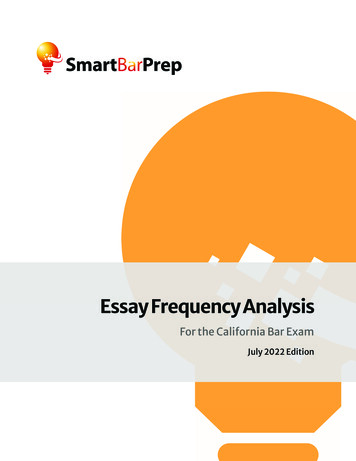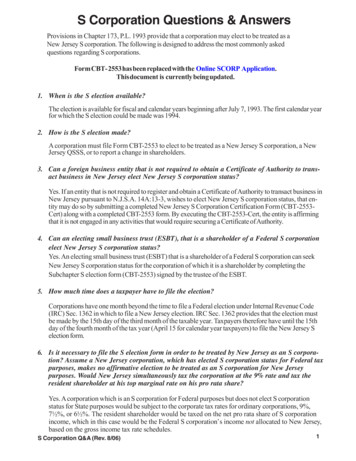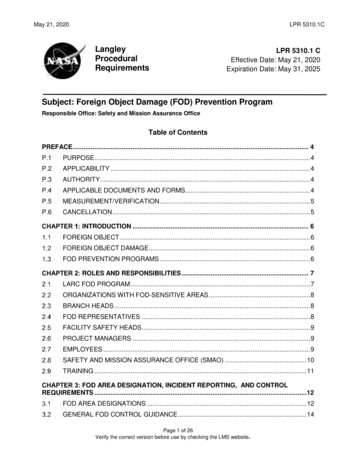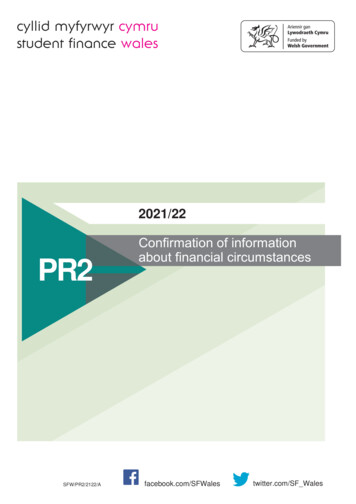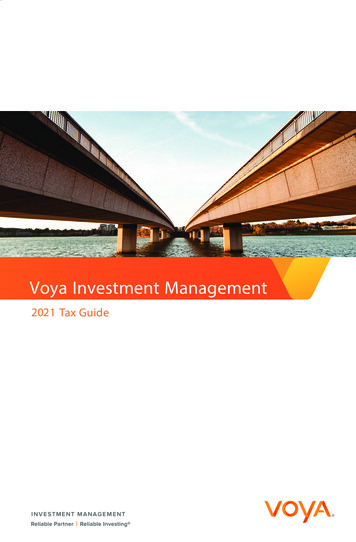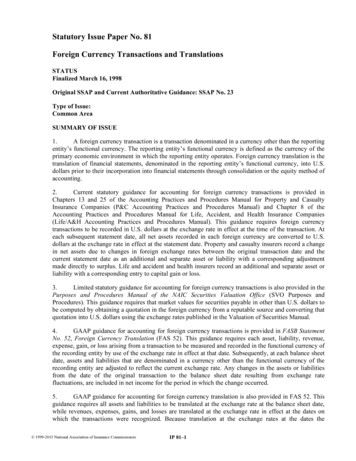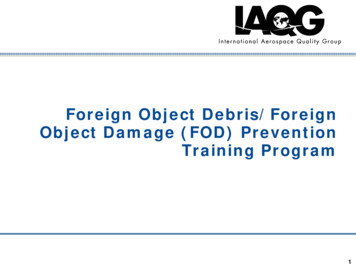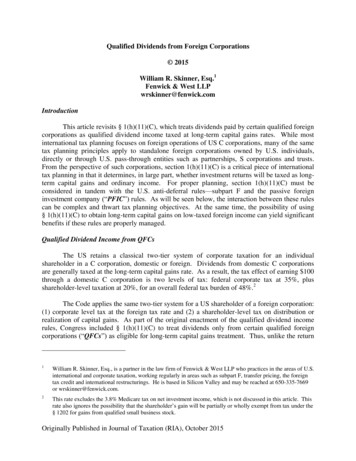
Transcription
Qualified Dividends from Foreign Corporations 2015William R. Skinner, Esq.1Fenwick & West LLPwrskinner@fenwick.comIntroductionThis article revisits § 1(h)(11)(C), which treats dividends paid by certain qualified foreigncorporations as qualified dividend income taxed at long-term capital gains rates. While mostinternational tax planning focuses on foreign operations of US C corporations, many of the sametax planning principles apply to standalone foreign corporations owned by U.S. individuals,directly or through U.S. pass-through entities such as partnerships, S corporations and trusts.From the perspective of such corporations, section 1(h)(11)(C) is a critical piece of internationaltax planning in that it determines, in large part, whether investment returns will be taxed as longterm capital gains and ordinary income. For proper planning, section 1(h)(11)(C) must beconsidered in tandem with the U.S. anti-deferral rules—subpart F and the passive foreigninvestment company (“PFIC”) rules. As will be seen below, the interaction between these rulescan be complex and thwart tax planning objectives. At the same time, the possibility of using§ 1(h)(11)(C) to obtain long-term capital gains on low-taxed foreign income can yield significantbenefits if these rules are properly managed.Qualified Dividend Income from QFCsThe US retains a classical two-tier system of corporate taxation for an individualshareholder in a C corporation, domestic or foreign. Dividends from domestic C corporationsare generally taxed at the long-term capital gains rate. As a result, the tax effect of earning 100through a domestic C corporation is two levels of tax: federal corporate tax at 35%, plusshareholder-level taxation at 20%, for an overall federal tax burden of 48%.2The Code applies the same two-tier system for a US shareholder of a foreign corporation:(1) corporate level tax at the foreign tax rate and (2) a shareholder-level tax on distribution orrealization of capital gains. As part of the original enactment of the qualified dividend incomerules, Congress included § 1(h)(11)(C) to treat dividends only from certain qualified foreigncorporations (“QFCs”) as eligible for long-term capital gains treatment. Thus, unlike the return1William R. Skinner, Esq., is a partner in the law firm of Fenwick & West LLP who practices in the areas of U.S.international and corporate taxation, working regularly in areas such as subpart F, transfer pricing, the foreigntax credit and international restructurings. He is based in Silicon Valley and may be reached at 650-335-7669or wrskinner@fenwick.com.2This rate excludes the 3.8% Medicare tax on net investment income, which is not discussed in this article. Thisrate also ignores the possibility that the shareholder’s gain will be partially or wholly exempt from tax under the§ 1202 for gains from qualified small business stock.Originally Published in Journal of Taxation (RIA), October 2015
from a domestic C corporation, which is subject to federal income taxation at a uniform blendedrate of 48%, the all-in tax rates on US shareholder’s investment in a foreign corporation mayvary from as low as 20% to 60% or more.3 The two levers to affect that tax rate are planning toreduce foreign corporate-level tax and ensuring that the shareholder level tax is imposed at thelong-term capital gains rate. Understanding and properly applying § 1(h)(11)(C), as well as thesubpart F and PFIC anti-deferral rules, is central to both aspects of this tax planning.Definition of a Qualified Foreign CorporationA qualified foreign corporation (“QFC”) is a foreign corporation that meets one of thefollowing three tests: (1) the corporation is organized in a U.S. possession; (2) the QFC iseligible for benefits of a “comprehensive” U.S. tax treaty that contains an exchange ofinformation provision; or (3) the stock of the QFC with respect to which the dividend is paid isregularly tradable on an established financial market in the United States.4 A foreign corporationcannot be a QFC if it is, or was during the preceding taxable year, a passive foreign investmentcompany (PFIC) within the meaning of § 1297.5The treatment of publicly traded and U.S. listed foreign corporations and possessionscorporations as QFCs is fairly straightforward. However, the Treaty test may apply to a range ofprivately-held foreign corporations, including both operating companies and Treaty-basedholding companies. As a starting point, the IRS maintains a list of tax treaties that areconsidered to be “comprehensive.” With the current or pending adoption of modern Limitationon Benefits (LOB) provisions throughout the US tax treaty network, essentially all income taxtreaties currently in force qualify as comprehensive.6The key question is what it means for a foreign corporation to be “eligible for benefits” ofthe treaty within the meaning of § 1(h)(11). For example, unless the QFC is being used to earnU.S. source income, it will not have any occasion to invoke the U.S. tax treaty and establish itseligibility for benefits at the corporate level. Thus, eligibility for the benefits of the tax treaty forpurposes of § 1(h)(11) is a purely hypothetical inquiry.7IRS rulings and the legislative history of § 1(h)(11) answer some of the questions aboutthis hypothetical treaty analysis. In PLR 200752029, the IRS employed a three-part frameworkfor analyzing the Treaty test of § 1(h)(11)(C). There, the taxpayer requested a ruling as to theapplication of § 1(h)(11) to an open-end, limited purpose investment trust. The investment trust3A 60% combined tax rate would apply if the foreign corporation were subject to foreign corporate-level tax of35%, and paid out non-qualified dividend income taxed at a rate of 39.6%.4§§ 1(h)(11)(C)(i) and 1(h)(11)(C)(ii).5§1(h)(11)(C)(iii).6The remaining exceptions are the 1973 Treaty with the USSR (currently applicable to certain former republics),Bermuda and the Netherlands Antilles. See Notice 2011-64, § 2.7See IRS Notice 2011-64, § 3 (“For purposes of determining whether it satisfies these requirements, a foreigncorporation is treated as though it were claiming treaty benefits, even if it does not derive income from sourceswithin the United States.”).Originally Published in Journal of Taxation (RIA), October 2015
was subject to taxation in the Treaty country (Country A) on its worldwide income, less adeduction for dividends paid. The investment trust filed IRS Form 8832 to elect to be classifiedas a corporation for US tax purposes.8 In ruling on § 1(h)(11)(C), the IRS applied the followingthree-part test:(1) Was the investment trust a corporation?(2) If the trust was a corporation, was it a tax resident of a Country A within the meaningof the US – Country A tax treaty?(3) Was the trust a “qualifying person” under the LOB Article of the Treaty?In answering these questions, the IRS viewed the first issue as a matter of US tax law, andanalyzed whether the trust was a fixed investment trust under Treas. Reg. § 301.7701-4(c) or abusiness entity. Due to the trustee’s power to reinvest proceeds of the certificate holders, thetrust was properly treated as a business entity that had elected corporate status for U.S. taxpurposes. This resolved the first question favorably for the taxpayer.In the PLR, the IRS viewed the second and third questions as involving the application ofthe treaty in the same manner as if the Trust were claiming treaty benefits for US source income.Although not explicitly stated, the reference to the trust being a “qualifying person” under theTreaty suggests that the IRS was looking for the taxpayer to show that the trust was entitled to allof the benefits of the treaty under the public trading or ownership-base erosion test,9 rather thanqualifying for hypothetical treaty benefits only with respect to certain items of income under theactive business test or derivative benefits test.10At the same time, the 2003 Conference Report underlying the enactment of § 1(h)(11)suggests a somewhat broader inquiry. Specifically, the Conference Report states:The conferees further intend that a company will be eligible for benefits of acomprehensive income tax treaty within the meaning of this provision if it wouldqualify for the benefits of the treaty with respect to substantially all of its incomein the taxable year in which the dividend is paid.As some commentators have persuasively argued, the reference to qualifying for benefits“substantially all of the income” likely refers to qualifying under the active business test.11 Thisresult also achieves a rational policy result in that a foreign corporation earning predominantlyactive business income from a business conducted in the treaty country necessarily has asubstantial, non-abusive presence in the foreign country. At the same time, there has not beenany guidance from the IRS endorsing this analysis.8The trust represented that it was not a PFIC, apparently due to an insurance business carried on throughsubsidiaries.92006 US Model Treaty, Articles 22(2)(c)(i) and 22(2)(e).102006 US Model Treaty Article 22(3); see also, e.g., 2001 US-UK Income Tax Treaty, Article 23(3).11New York State Bar Association Report No. 1113 (June 26, 2006) at pp. 21-25.Originally Published in Journal of Taxation (RIA), October 2015
A recent ILM 201343019 (Sept. 10, 2013) addressed treaty eligibility for § 1(h)(11)purposes under the “principal purpose test” of the US – Cyprus treaty. There, a US individualowned an interest in the Cyprus Holding Company, which owned an operating company in athird country. The ownership-base erosion test was not satisfied because it required a certainpercentage of Cypriot ownership. Article 26(2) of the U.S. - Cyprus Treaty contains a special“principal purpose” test, which allows for benefits “if it is determined that the establishment,acquisition and maintenance of such person and the conduct of its operations did not have as aprincipal purpose obtaining benefits under the Convention.”12 In the ILM, the IRS found that theCypriot company was being maintained in Cyprus for reasons unrelated to obtaining benefitsunder the Treaty and could not have been treaty shopping in violation of Article 26(2) when ithad no US source income. Moreover, the IRS did not seem to view the purpose of establishinga holding company that qualified for § 1(h)(11) as a tainted purpose under the Cyprus treaty.A number of other technical questions remain unanswered under § 1(h)(11)’s treaty test.For example, one important question is when exactly must be the foreign corporation paying thedividend be a QFC. The legislative history cited above refers to the foreign corporationqualifying for treaty benefits in the “taxable year in which the dividend is paid.” If the foreigncorporation did not qualify for benefits in a previous year, but becomes eligible for treatybenefits in the current year, it would, therefore, seem to be able to pay qualified dividend incomeduring the current year out of earnings derived from prior years in which it was not a QFC.13Similarly, if dividends from a non-QFC are paid to a QFC, it would seem that the fact that theunderlying earnings may be traced to a non-QFC is irrelevant.Planning under the Ownership – Base Erosion TestPerhaps the most straightforward path into § 1(h)(11)(C) is through the ownership-baseerosion test. In several major U.S. tax treaties, the ownership test can be established by having atleast 50% US ownership of the treaty corporation. For example, Article 24(2)(c) of the US Luxembourg Treaty of 1996 allows a Luxembourg company to qualify for treaty benefits wherethe following two conditions are met: (1) at least 50% of the principal class of shares are“ultimately owned” by persons that are qualified residents or US citizens; and (2) deductiblepayments made to persons other qualified residents or US citizens do not exceed 50% of thecompany’s gross income. The two conditions, qualifying ownership and absence of baseerosion, are incorporated in most US tax treaties through the so-called “ownership-base erosiontest.”This test works well with § 1(h)(11) planning in that, if the proper treaty jurisdiction ischosen, the qualifying US ownership for treaty purposes may be supplied entirely by US owners.So long as the holding company does not engage in prohibited “base erosion,” it would be aqualified person that allows its majority US owners to derive qualified dividend income. For12US – Cyprus Income Tax Treaty of 1984, Article 26(2).13Where the regulations require earnings to be traced to a particular source to obtain beneficial tax treatment, theyhave explicitly so provided. Cf. Treas. Reg. § 1.954-2(b)(4)(ii)(A)(2) (same country exception requires E&P tobe accumulated during period payor and recipient were related parties).Originally Published in Journal of Taxation (RIA), October 2015
example, it might be possible for the QFC to make deductible payments under a hybridinstrument to US shareholders. Even if deductible for local country tax purposes, such paymentsgenerally would not count towards the base erosion threshold if made to qualifying persons.Check-the-box planning involving subsidiaries of the Treaty country holding company mightalso facilitate foreign tax reduction. In addition to a favorable treaty test, other importantfeatures of a potential holding company for this purpose are relaxed CFC rules, participationexemption, and reduced rate of foreign withholding tax on outbound dividends.Interaction of § 1(h)(11) with the Anti-Deferral RulesWhile the above discussion provides an overview of obtaining § 1(h)(11) benefits fromthe foreign corporation, it only represents half of the necessary analysis. If a foreign corporationis also a controlled foreign corporation (“CFC”) and/or passive foreign investment company(“PFIC”) with respect to the US owners, the anti-deferral rules can significantly curtail theshareholders’ ability to derive qualified dividend income. As discussed below, PFICs are noteligible for § 1(h)(11)(C) unless covered by the CFC overlap rule. CFCs, on the other hand,continue to be eligible for the benefits of § 1(h)(11), but not with respect to subpart F income orsection 956 investments (unless a § 962 election is made). In addition, gain from the sale of CFCstock may be characterized as a dividend under § 1248, which makes the CFC’s eligibility for§ 1(h)(11) at the time of exit particularly important.Interaction with PFICSection 1(h)(11)(C)(iii) disallows the benefits of qualified dividend income with respectto any foreign corporation that is, or was during the preceding taxable year, a passive foreigninvestment company as defined under § 1297. As a potential trap for the unwary, this test differsin some respects from what constitutes an ownership interest in a § 1291 fund that is viewed ascarrying a “PFIC taint.”First, the rule applies irrespective of whether a qualified electing fund (“QEF”) electionhas been made by the shareholder. Under the QEF rules, if a shareholder makes a QEF electionfor the first year of its holding period of a PFIC (a so-called “pedigreed QEF”), the shareholderis no longer treated as a § 1291 fund with respect to the shareholder. If the corporationconstitutes a PFIC under the asset test or income test for the year, even if treated as a QEF,dividends will not constitute qualified dividend income even though gain from the sale of shareswould be capital gains. Moreover, this disqualification rule also applies if the corporation, as apedigreed QEF, failed the income test or asset test during the previous year. Thus, even if theshareholder has made a QEF election and purged its PFIC history, it must nonetheless wait atleast a year before the foreign corporation is able to pay a qualified dividend.Second, while the statute refers to the corporation being a PFIC as defined in § 1297(seemingly a corporate-level determination), the IRS has interpreted this test to apply on ashareholder-by-shareholder basis.14 Depending on the shareholder’s situation, this rule can befavorable or unfavorable. On the one hand, a shareholder in a prior PFIC that is subject to the14Notice 2004-70, § 7.02Originally Published in Journal of Taxation (RIA), October 2015
once-a-PFIC, always-a-PFIC rule of § 1298(b)(1) cannot receive capital gains distributions fromthe PFIC until its holding period is purged. On the other hand, the Notice provides that a foreigncorporation’s status as a PFIC with respect to the shareholder takes into account the CFC overlaprule of § 1297(d). Under this rule, even if the foreign corporation’s assets are predominantlypassive, the PFIC rules will not, as noted above, override § 1(h)(11) treatment as to a U.S.shareholder in a CFC. This rule can be useful, for example, where a foreign corporation that isboth a PFIC and a CFC derives active income not subject to current taxation under subpart F.Even if the entity’s assets are largely passive, the CFC overlap rule may allow dividends out ofnon-previously taxed earnings to remain qualified dividend income.Interaction with Subpart FSection 1(h)(11), as noted above, does not preclude a taxpayer from receiving qualifieddividend income from a CFC. Under Notice 2004-70, § 4.01, qualified dividend incomeincludes gain from the sale of CFC stock that is re-characterized as a dividend under § 1248.However, subpart F inclusions under § 951(a)(1), both with respect to subpart F incomeand earnings invested in U.S. property, are treated as ordinary income by the IRS.15 Thisconclusion has been a matter of some discussion.16 However, the Tax Court in Rodriguez v.Commissioner, affirmed by the Fifth Circuit,17 held that inclusions under § 951(a)(1)(B) wouldnot be treated as qualified dividend income. Whatever the merits of the Rodriguez decision, ataxpayer inclined to take a different view would now need to litigate contrary to a decision of theTax Court with a view towards achieving a more favorable result in a circuit outside the FifthCircuit.Depending on the fact pattern, the Rodriguez analysis can create significant traps for aUS individual with an interest in a CFC that generates subpart F income or makes § 956investments. With respect to a CFC holding investments that would otherwise generate longterm capital gain, such as certain real estate or a portfolio of equity securities, the treatment ofgains as subpart F income under § 954(c) may, in effect, convert the character from capital gainsto ordinary income without deferral. Similarly, in the case of an operating CFC that generatessubpart F sales or services income that is subject to significant foreign tax, subpart F may causethe amounts to be currently taxed at ordinary rates, but without a foreign tax credit for foreignincome taxes imposed that would be available if the operations were conducted through a hybridentity. In either case, subpart F may sometimes lead to the conclusion that the shareholder wouldbe better off checking the box to treat the foreign corporation as a flow-through entity for U.S.tax purposes to claim direct foreign tax credits under § 901 or the rate preference for capitalgains.15Notice 2004-70, § 4.0216See, e.g., Jeffrey Rubinger, Turning Water into Wine: The Use of Offshore Holding Companies to Convert LowTaxed Income into 'Qualified Dividend Income', 2004 TNT 92-53 (May 12, 2004).172013-2 USTC ¶50,420 (5th Cir. 2013), aff’g 137 T.C. 174 (2011)Originally Published in Journal of Taxation (RIA), October 2015
Use of a § 962 Election in Combination with § 1(h)(11)One little known, but in this context important, provision of Subpart F is § 962. Section962(a) allows the US individual to elect to be treated as if it were a domestic C corporation, andlimit its tax on subpart F income to an amount that would be imposed if the subpart F incomehad been earned by a domestic corporation and the corporation were eligible to claim an indirectcredit under § 960.18 This election, which is made year-by-year by each individual shareholderwith respect to all of its CFCs, can yield significant benefits in two respects. First, theavailability of the indirect foreign tax credit under § 960 in the calculation prevents high-taxedsubpart F income from being subject to confiscatory rates of tax. Second, in the case of a foreigncorporation paying significant foreign tax, section 962 may, in effect, take the teeth out ofRodriguez decision by preventing subpart F from converting qualified dividend income intoordinary subpart F income.19The effect of a § 962 election is illustrated through the following a simplified calculationsin the case of two CFCs M (high taxed) and CFC N (low-taxed). At the outset, the § 962(a)election results in a significant deferral of tax with respect to the subpart F income inclusion:Pre-Tax Subpart F IncomeForeign taxesNet Sub F inclusionNet Fed Tax on Sub F Income at 39.6%CFC M 1,000,000 400,000 600,000 237,600CFC N 1,000,000 150,000 850,000 336,600 1,000,000 350,000- 350,000 0 0 237,60023.8% 1,000,000 350,000- 150,000 200,000 200,000 136,60013.7%Impact of Section 962 ElectionHypothetical Dividend with Sec. 960 Gross-upHypothetical Pre-credit corporate taxLess Hypothetical Section 960 CreditHypothetical Corp Tax under Sec. 962(a)Net Tax on Sub F under Sec. 962(a)Taxes Initially Deferred Through ElectionAs % of Total Pre-Tax IncomeThe cost of electing § 962 relief is the limitation of a PTI exclusion on an actual dividend18See §§ 962(a)(1) and 962(a)(2). A parallel provision applies for purposes of limiting an individualshareholder’s tax on § 1248 deemed dividend income to the amount of tax that would have applied had theamounts been earned by a domestic corporation. See § 1248(b)(1).19Some have suggested on technical grounds that the § 962(d) amounts may be an income inclusion, rather than adividend eligible for § 1(h)(11). See Scott A. Harty and Hale E. Sheppard, Repatriating Subpart F Income: AFresh Look at Electing to Be Taxed as a Corporation, 2005 WTD 70-21 (Apr. 13, 2005). However, this viewseems to read § 962(d) in an overly broad manner. Section 962(d) only operates to turn off § 959(a)(1), whichexcludes certain dividends of a CFC’s earnings and profits from gross income. But for the § 959(a) exclusion,such distributions would seem to plainly be dividends under § 316 principles.Originally Published in Journal of Taxation (RIA), October 2015
to the amount of tax paid on the subpart F income inclusion.20 The remaining amounts are noteligible for the § 959(a) exclusion, and thus become fully taxed as a dividend from the foreigncorporation. The apparent rationale is that this amount would be the same as the after-taxearnings of the C corporation (after § 960 indirect credit) available for a dividend to the U.S.shareholder.Including this second-level tax on the actual distribution determines whether electing§ 962 yields a permanent cost or benefit, or merely a deferral of U.S. taxes on subpart F incomewith a permanent increase or neutral effect on the all-in tax rate. This is illustrated in the tablebelow, which continues the numerical analysis from the above examples.CFC M 1,000,000 400,000 600,000 237,600CFC N 1,000,000 150,000 850,000 336,600 0 200,000Second-Level Dividend After PTITax at 20% QDI RateNet Permanent Savings / (Cost) v. NoElection 600,000 120,000 650,000 130,000 117,600 6,600Tax at 39.6% OI RateNet Savings / (Cost) v. No Election 237,600 0 257,400- 120,800Pre-Tax Subpart F IncomeForeign taxesNet Sub F inclusionNet Fed Tax on Sub F Income at 39.6%Total Section 962(a) Tax in Year of InclusionThe second level tax under § 962(d) is triggered by an actual distribution of the PTI.Notably, Section 962(d) provides that § 962 PTI is not treated as PTI for purposes of § 959(a)(1),but does not override § 959(a)(2). Thus, it seems that § 962 PTI triggered by a subpart Finclusion remains available to be lent to the U.S. shareholder tax-free without suffering a § 956inclusion.21Interaction with § 1248Section 1248 deemed dividends, unlike subpart F inclusions, are eligible for treatment asqualified dividend income.22 Thus, on a sale of a CFC by US individuals, the § 1248 “pickup”remains eligible for a reduced rate of tax. This can be especially significant where the buyer is a20See Treas. Reg. § 1.962-1(d), Example 2.21Other aspects of upstream loans in the context of repatriation are currently under challenge in the pending taxcourt litigation filed in Illinois Tool Works et al. v. Commissioner, Docket No. 10418-14. However, thetreatment of a bona fide loan from a corporation to its shareholder as excluded from gross income remains anestablished legal principle outside of the application of § 956.22See Notice 2004-70, § 4.01.Originally Published in Journal of Taxation (RIA), October 2015
US corporation that requires a § 338(g) election to be made. Such an election will create largeamounts of E&P in the CFC being sold, and absent § 1(h)(11), convert capital gain into ordinarydividend income. If the dividend income is qualified dividend income, however, theshareholders may be indifferent as to the § 338(g) election being made with respect to its CFCs.In a tiered CFC structure, the § 1248 deemed dividend takes into account earnings oflower-tier CFCs.23 In order to computing a US corporate shareholder’s indirect credit under§ 902, the § 1248 dividend is deemed made proportionately from each lower-tier CFC’s E&Pand tax pools as if a direct dividend were paid to the parent.24 However, if the first-tier CFC is aQFC, but the lower-tier CFCs are not QFCs, does § 1(h)(11) apply to the portion of the § 1248deemed dividend sourced from lower-tier CFCs that are not QFCs? It may be advisable in suchcases to check-the-box on any lower-tier non-QFCs into a QFC prior to the sale, so that there isno possible dividend from a non-QFC in the § 1248 transaction.In addition, section 1248(b) limits an individual’s tax on a § 1248 deemed dividend to theamount of tax that would have been incurred on a sale of stock in a domestic C corporation thathad earned the CFC’s undistributed earnings and claimed a foreign tax credit. While thecomputations of the § 1248(b) are detailed,25 they will generally yield a benefit if the § 1248dividend would not otherwise be treated as QDI and if the earnings are subject to appreciableforeign tax (i.e., 10% or more). If the foreign corporation is a QFC, the § 1248(b) limitation willgenerally be inapplicable because the § 1248 deemed dividend is only subject to shareholderlevel tax. 26Proposed Legislation and Certain Hybrid TransactionsIn 2007, legislation was proposed in Congress to curtail the benefits of § 1(h)(11) incertain circumstances.27 Specifically, the 2007 proposals bills would have created a newcategory of “non-qualified dividend income” from a foreign corporation, where any of thefollowing requirements were met: (1) the corporation is not treated as a corporation under thelaws of the country to which it would be subject if it were a corporation; (2) such corporation isexempt from tax in its home country; (3) such corporation would be a PFIC, determined withoutregard to the CFC overlap rule of § 1297(d); or (4) such dividend is paid with respect to a hybridinstrument treated as debt under local law. While such bills would seem unlikely to obtaintraction in the near future, they nonetheless highlight certain practices that Congress believed23§ 1248(c)(2).24See Treas. Reg. § 1.1248-1(d).25See Treas. Reg. § 1.1248-4.26Rev. Rul. 69-124 holds that the § 1248(b) limitation applies to CFC stock held by an individual indirectlythrough a domestic partnership. By contrast, some have reported that the IRS has taken a different approach tointerpretation of § 962 and limited it to CFC stock owned directly by an individual or US estate or trust.See Rubinger & LaPree, IRS Takes Flawed Approach to Inclusion under Subpart F, 2009 TNT 94-10 (May 18,2009).27See Neal Bill, HR 1672 (Mar. 23, 2007); Kerry Bill, S. 1008 (Mar. 28, 2007).Originally Published in Journal of Taxation (RIA), October 2015
might warrant legislative action.ConclusionIn short, at age 12, section 1(h)(11) remains a fruitful area of tax planning for foreigncorporations owned by US individual shareholders directly and through pass-through entities.After an uncertain period as a temporary tax provision, it graduated in 2013 into a permanentfeature of the Code, and a well-advised taxpayer will find many opportunities to maximize thebenefits of the provision. At the same time, the PFIC and subpart F anti-deferral rules presentsignificant roadblocks. If not properly managed, these anti-deferral provisions may negate thetaxpayer’s efforts to maximize the benefits of § 1(h)(11) or, in some cases, make the taxpayerworse off than if no tax planning were undertaken at all.Originally Published in Journal of Taxation (RIA), October 2015
The US retains a classical two-tier system of corporate taxation for an individual shareholder in a C corporation, domestic or foreign. Dividends from domestic C corporations are generally taxed at the long-term capital gains rate. As a result, the tax effect of earning 100 . (RIA), October 2015
